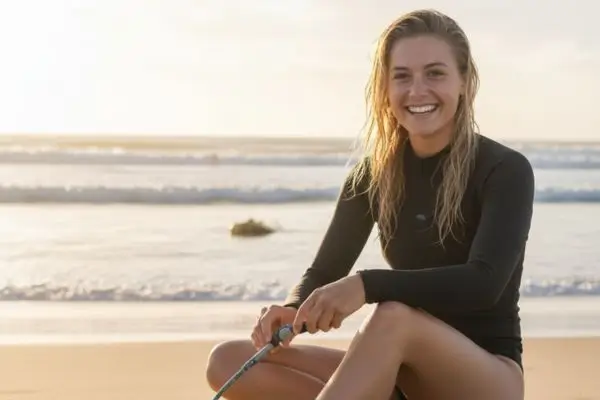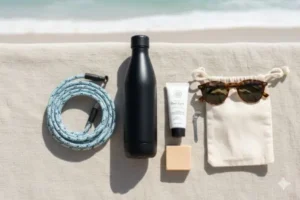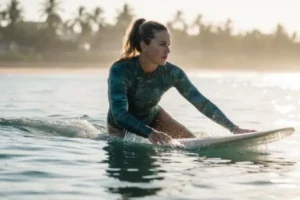For beginner surfers, the leash is one of the most important pieces of gear. It keeps the board close, prevents accidents, and builds confidence in the water. Yet, many traditional surfboard leashes are made with petroleum-based plastics and synthetic rubbers that pollute the environment during production and disposal.
Fortunately, eco-friendly surfboard leashes are now available, giving new women surfers the chance to learn and progress while staying aligned with sustainable values. These leashes combine durability, safety, and environmental responsibility — exactly what a beginner needs when catching her first waves.
Why Traditional Leashes Aren’t Eco-Friendly
A typical surf leash is built from urethane cords, plastic swivels, and neoprene ankle cuffs. While strong, they create long-term environmental issues:
- 🛢️ Petroleum-Based Materials: Extracted and processed with high carbon emissions.
- ♻️ Non-Biodegradable: Once broken, most leashes end up as landfill waste or ocean debris.
- 🌊 Ocean Impact: If lost during surf sessions, they add to plastic pollution.
For beginners, who may replace gear more often, this can contribute significantly to waste.
What Makes a Surfboard Leash Eco-Friendly?
Eco-friendly leashes are designed with sustainable materials and responsible manufacturing practices. They maintain the same safety standards as conventional leashes while minimizing environmental impact. Key features include:
- Recycled Urethane Cords: Reusing existing plastic waste instead of creating new.
- Plant-Based or Biodegradable Alternatives: Some brands explore natural rubber or bio-based polymers.
- Recycled or Organic Ankle Straps: Made from organic cotton, hemp, or recycled PET.
- Durable Stainless Steel Swivels: Long-lasting and recyclable.
- Eco Packaging: Plastic-free, often compostable or recyclable cardboard.
Benefits for Beginner Women Surfers
Choosing eco-friendly surfboard leashes brings both personal and planetary advantages:
- 🌱 Lower Carbon Footprint: Materials reduce reliance on fossil fuels.
- 🌊 Cleaner Oceans: Fewer plastics entering marine environments.
- 🏄 Beginner Confidence: High-quality eco leashes are just as strong and reliable.
- 💪 Durability: Many eco leashes are designed to last longer, reducing replacements.
- 🎀 Style Meets Sustainability: Natural fibers and eco fabrics add a unique look.
Step-by-Step: How to Choose the Right Eco Leash
Step 1: Pick the Correct Length
As a beginner, choose a leash that is equal to or slightly longer than your board. For example, an 8-foot board pairs with an 8-foot leash.
Step 2: Check the Cord Material
Look for recycled urethane or bio-based cords. They’re strong but less harmful to the planet.
Step 3: Test the Cuff Comfort
Opt for ankle straps with organic cotton lining or recycled padding for softness and comfort.
Step 4: Verify Swivel Durability
Ensure swivels are stainless steel or another corrosion-resistant, recyclable metal.
Step 5: Look for Certified Brands
Choose brands with environmental certifications or strong sustainability commitments.
Recommended Eco-Friendly Leash Materials
- Recycled Urethane: Maintains strength while reusing plastic waste.
- Natural Rubber: Biodegradable and flexible.
- Hemp Straps: Breathable, durable, and sustainable.
- Organic Cotton Lining: Soft on the skin, eco-conscious in production.
- Stainless Steel or Brass Swivels: Durable and recyclable alternatives to plastic.
Leading Brands in Eco Leashes
A few companies stand out in offering eco-friendly surfboard leashes:
- Wave Tribe: Pioneers in hemp-based ankle cuffs and recycled urethane cords.
- Balin Eco Leashes: Focused on reducing plastic use and offering biodegradable packaging.
- Re-Leash Projects: Small-scale artisans repurposing waste materials into unique, eco cords.
For beginners, these brands offer accessible and safe options without compromising on sustainability.
DIY Option: Making Your Own Eco Leash
For women surfers who love creativity and hands-on solutions, a DIY leash is possible:
- Use a recycled urethane cord or reclaimed climbing rope.
- Attach metal swivels from hardware stores.
- Sew an ankle strap from hemp or organic cotton fabric.
- Add padding with recycled neoprene or cork.
This approach is not only sustainable but also gives a personal connection to the gear.
Building an Eco Surf Kit as a Beginner
An eco-friendly leash is just one piece of the puzzle. Beginner women surfers can also explore:
- Sustainable surfboards made from recycled foam or natural resins.
- Organic wetsuits designed with plant-based neoprene alternatives.
- Eco surf waxes that avoid petroleum.
- Recycled surfboard bags for responsible storage.
Together, these swaps form a complete kit that supports both surfing progress and environmental care.
Catching Waves with Purpose
Every surfer remembers her first leash — it’s the lifeline that keeps her safe and confident. For beginner women, choosing an eco-friendly option means starting the surf journey with purpose. It’s not just about learning to ride waves, but about learning to protect the ocean that creates them.
Eco-friendly surfboard leashes remind us that even small choices — like the cord that ties us to our board — can create ripples of positive change. By making sustainable decisions from the very beginning, women surfers prove that surfing is more than a sport: it’s a lifestyle that honors the sea.




